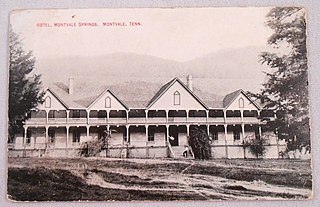
Thomas Alva Edison was an American inventor and businessman. He developed many devices in fields such as electric power generation, mass communication, sound recording, and motion pictures. These inventions, which include the phonograph, the motion picture camera, and early versions of the electric light bulb, have had a widespread impact on the modern industrialized world. He was one of the first inventors to apply the principles of organized science and teamwork to the process of invention, working with many researchers and employees. He established the first industrial research laboratory.

Delta blues is one of the earliest-known styles of blues. It originated in the Mississippi Delta and is regarded as a regional variant of country blues. Guitar and harmonica are its dominant instruments; slide guitar is a hallmark of the style. Vocal styles in Delta blues range from introspective and soulful to passionate and fiery.

Appalachia is a geographic region located in the central and southern sections of the Appalachian Mountains of the eastern United States. Its boundaries stretch from the western Catskill Mountains of New York into Pennsylvania, continuing on through the Blue Ridge Mountains and Great Smoky Mountains into northern Georgia, Alabama, and Mississippi, with West Virginia being the only state in which the entire state is within the boundaries of Appalachia. In 2021, the region was home to an estimated 26.3 million people, of whom roughly 80% were white.

Great Smoky Mountains National Park is an American national park in the southeastern United States, with parts in North Carolina and Tennessee. The park straddles the ridgeline of the Great Smoky Mountains, part of the Blue Ridge Mountains, which are a division of the larger Appalachian Mountain chain. The park contains some of the highest mountains in eastern North America, including Clingmans Dome, Mount Guyot, and Mount Le Conte. The border between the two states runs northeast to southwest through the center of the park. The Appalachian Trail passes through the center of the park on its route from Georgia to Maine. With 13 million visitors in 2023, the Great Smoky Mountains National Park is the most visited national park in the United States.

Thomas Lanier Clingman, known as the "Prince of Politicians," was a Democratic member of the United States House of Representatives from 1843 to 1845 and from 1847 to 1858, and U.S. senator from the state of North Carolina between 1858 and 1861. During the Civil War, he refused to resign his Senate seat and was one of the many southern state senators subsequently expelled from the Senate in absentia. He then served as a general in the Confederate States Army.

Mount Jefferson is a mountain located in Ashe County, North Carolina. The mountain is part of the Mount Jefferson State Natural Area. The mountain has an elevation of 4,665 feet (1,422 m) above sea level, and it sharply rises more than 1,600 feet above the towns of Jefferson, North Carolina and West Jefferson.

Clingmans Dome is a mountain in the Great Smoky Mountains of Tennessee and North Carolina in the Southeastern United States. Its name in Cherokee is Kuwahi or Kuwohi, meaning "mulberry place."

Elisha Mitchell was an American educator, geologist and Presbyterian minister. His geological studies led to the identification of North Carolina's Mount Mitchell as the highest peak in the United States east of the Mississippi River.

The Black Mountains are a mountain range in western North Carolina, in the southeastern United States. They are part of the Blue Ridge Province of the Southern Appalachian Mountains. The Black Mountains are the highest mountains in the Eastern United States. The range takes its name from the dark appearance of the red spruce and Fraser fir trees that form a spruce-fir forest on the upper slopes which contrasts with the brown or lighter green appearance of the deciduous trees at lower elevations. The Eastern Continental Divide, which runs along the eastern Blue Ridge crest, intersects the southern tip of the Black Mountain range.

During the American Civil War, North Carolina joined the Confederacy with some reluctance, mainly due to the presence of Unionist sentiment within the state. A popular vote in February, 1861 on the issue of secession was won by the unionists but not by a wide margin. This slight lean in favor of staying in the Union would shift towards the Confederacy in response to Abraham Lincoln's April 15 proclamation that requested 75,000 troops from all Union states, leading to North Carolina's secession. Similar to Arkansas, Tennessee, and Virginia, North Carolina wished to remain uninvolved in the likely war but felt forced to pick a side by the proclamation. Throughout the war, North Carolina widely remained a divided state. The population within the Appalachian Mountains in the western part of the state contained large pockets of Unionism. Even so, North Carolina would help contribute a significant amount of troops to the Confederacy, and channel many vital supplies through the major port of Wilmington, in defiance of the Union blockade.
Richard Patrick McCormick was a historian, former university professor of history, administrator, professor emeritus at Rutgers University in New Brunswick, New Jersey, and president of the New Jersey Historical Society. McCormick was internationally recognized for his expertise in New Jersey and early American political history.

The Upland South and Upper South are two overlapping cultural and geographic subregions in the inland part of the Southern United States. They differ from the Deep South and Atlantic coastal plain by terrain, history, economics, demographics, and settlement patterns.

Mount Guyot is a mountain in the Great Smoky Mountains, located in the southeastern United States. At 6,621 feet (2,018 m) in elevation, Guyot is the fourth-highest summit in the Eastern U.S., and the second-highest in the Great Smoky Mountains National Park. While the mountain is remote, the Appalachian Trail crosses its south slope, passing to within 1,000 feet (300 m) of the summit.
Huntsville is a small unincorporated community in Yadkin County, North Carolina, United States. The community was formerly chartered in 1792 by Charles Hunt of Salisbury, NC and was chartered again in 1822. It has a Huntsville Volunteer Fire Department, and Huntsville Community Center which is in front of a baseball/softball field which is home to Huntsville little league.
The Pisgah phase is an archaeological phase of the South Appalachian Mississippian culture in Southeast North America. It is associated with the Appalachian Summit area of southeastern Tennessee, Western North Carolina, and northwestern South Carolina in what is now the United States.
Ann Dexter Gordon is an American research professor in the department of history at Rutgers University and editor of the papers of Elizabeth Cady Stanton and Susan B. Anthony, a survey of more than 14,000 papers relating to the pair of 19th century women's rights activists. She is also the editor of the multi-volume work, Selected Papers of Elizabeth Cady Stanton and Susan B. Anthony, and has authored a number of other books about the history of the women's suffrage movement. She worked with popular historian Ken Burns on his 1999 book and appears in his documentary film about Stanton and Anthony. Since 2006, Gordon has repeatedly weighed in on the Susan B. Anthony abortion dispute stating that "Anthony spent no time on the politics of abortion. It was of no interest to her."

The Asheville and Spartanburg Railroad was a Southern United States railroad that served South Carolina and North Carolina in the late 19th century and early 20th century.

Montvale Springs is a location in Blount County, Tennessee, United States, that was once the site of a fashionable resort hotel, and is now a summer camp.

Helen Dingman was an American academic and social worker who was one of the central figures in the Progressive and New Deal eras to bring social and economic reform to Appalachia. After teaching in Massachusetts for five years from 1912 to 1917, Dingman moved to Kentucky to establish the Smith Community Life School under the auspices of the United Presbyterian Church. Serving as principal and directing six other schools in Harlan County, Kentucky, she provided both education and social services to the community until 1922. After a two-year placement as an assistant superintendent for the mission board in New York, she was hired as a teacher in the Sociology Department at Berea College. She taught social work courses and trained teachers for the rural schools in the region until 1952. In addition, she served as Executive Secretary of the Conference of Southern Mountain Workers, establishing the professional basis for social workers. The first comprehensive economic and social survey of the Southern Appalachias was spearheaded by Dingman.

Slavery was legally practiced in the Province of North Carolina and the state of North Carolina until January 1, 1863, when President Abraham Lincoln issued the Emancipation Proclamation. Prior to statehood, there were 41,000 enslaved African-Americans in the Province of North Carolina in 1767. By 1860, the number of slaves in the state of North Carolina was 331,059, about one third of the total population of the state. In 1860, there were nineteen counties in North Carolina where the number of slaves was larger than the free white population. During the antebellum period the state of North Carolina passed several laws to protect the rights of slave owners while disenfranchising the rights of slaves. There was a constant fear amongst white slave owners in North Carolina of slave revolts from the time of the American Revolution. Despite their circumstances, some North Carolina slaves and freed slaves distinguished themselves as artisans, soldiers during the Revolution, religious leaders, and writers.
















